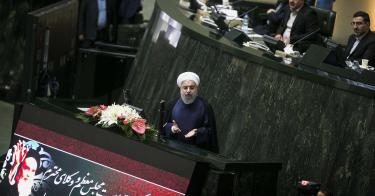The Iran nuclear deal is a ticking time bomb.
That’s because Team Trump has to (re)certify to Congress that Iran is in technical compliance with the 2015 nuclear deal — aka the Joint Comprehensive Plan of Action — by Oct. 15.
It may not happen based on President Trump’s unvarnished feelings about the deal, calling it an “embarrassment” and the “worst deal ever” last week while at the United Nations.
The pact could explode any time.
Trump also said he’d made up his mind about what to do about it — though he didn’t tip his hand as to what exactly that was. If I had to bet, it isn’t a continuation of the status quo.
Considering the deal’s shortcomings, that’s understandable.
Of course, some defenders of the Obama-era atomic agreement will argue that it paused — or at least significantly slowed — Iran’s progress toward nukes for a decade or so.
Indeed, that’s one of the big problems with the pact: It expires. The deal has a “sunset provision,” which is when key restrictions on Iran’s uranium enrichment program are phased out, leaving Tehran footloose and fissile free to build a bomb.
Indeed, President Obama acknowledged in a 2015 NPR interview that after vital restrictions in the deal expire at the 15-year mark, Tehran could produce enough fissile material for a bomb in no time.
Isn’t that comforting?
Naturally, Tehran insists it was never interested in nukes — which doesn’t explain why Iran ran a clandestine, treaty-cheating program, including hiding some of its (undeclared) atomic facilities underground.
Hmmm … but that’s not all.
The agreement also doesn’t stipulate that the U.N.’s International Atomic Energy Agency staff can immediately inspect suspect Iranian military sites. Tehran says no way, calling the idea of allowing it “a dream,” according to Reuters.
Tell me: How can you feel confident in verifying compliance with the agreement based on limited inspection rights — on top of two decades of Iranian denials and deception on its atomic activities?
Uh, you can’t.
The deal also shockingly allows Iran to continue centrifuge research, meaning Tehran will be more efficient and effective in enriching uranium for bombs with each passing year.
The atomic agreement never addressed Iran’s burgeoning ballistic missile program, either, an important component of a full-up nuclear weapons program — as we’re seeing today with North Korea.
Indeed, Iran’s “fake” launch of a medium-range ballistic missile last Friday is likely only a temporary propaganda setback to Tehran’s missile program.
With or without outside help, Iran could easily be as threatening in 12 years in atomic affairs as North Korea is today. More troubling: Trump tweeted last weekend that North Korea is already “working with” Iran.
Talk about an Axis of Evil.
The lifting of economic sanctions also fills the mullahs’ pockets with funds that support its mischief-making, including supporting the Syrian regime, Yemeni Houthi rebels and the terror groups, Hezbollah and Hamas.
Is any of that in America’s interest?
Even if Tehran is currently in technical compliance, the pact leaves Iran as a “threshold” nuclear state and won’t stop it from becoming a de facto nuclear power in the not-too-distant future.
It’s no wonder that Team Trump may soon call for a deal do-over.
This piece originally appeared in The Boston Herald


